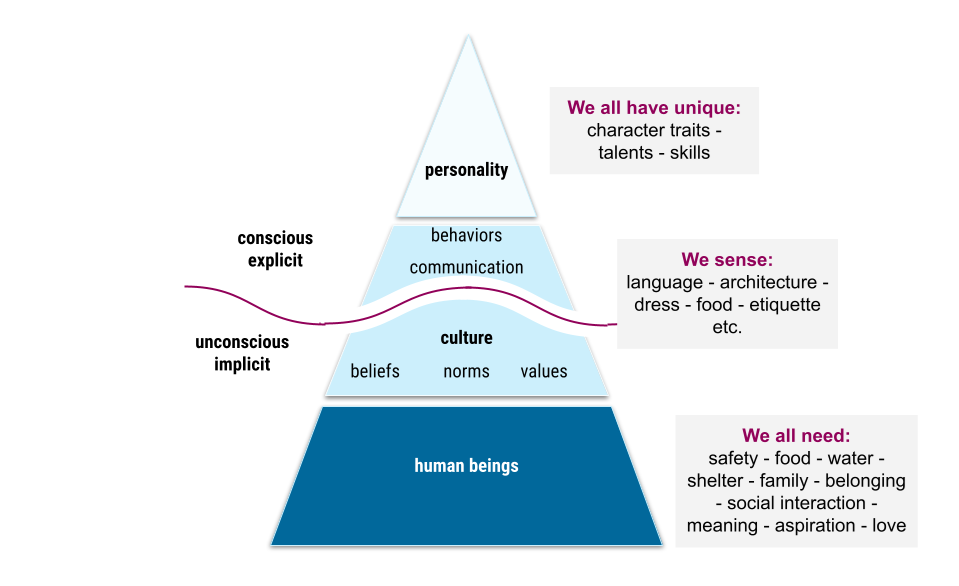How we experience culture
How we experience culture
Cultural artefacts and symbols are displayed easily, but deeper lying values and beliefs are more implied. And how we can distinguish between behaviors that are cultural i.e. determined by the group, and personal i.e. determined by the individual?
Please have a look at Hofstede's pyramid model below.
[text continues below illustration]

Geert Hofstede's pyramid model offers three levels that may help to clarify the difference between humankind, group behavior and personality traits.
Level 1: We are all Humans
Whether people are born in Amsterdam, Cairo, La Paz or the Solomon islands, at the end of the day all human beings are in search for the same essentials in life. We all need shelter, safety, means of existance, love, recognition, a sense of belonging, other humans and many more basic needs.
Level 2: Our way of life
A group of people has developed a common understanding and survival strategy regarding how to secure these basic needs. Culture is about group behavior and group identity. Based on specific circumstances and shared histories groups of people have formed unique visions of life and social constructs. But what works nicely for one group of people may not do so for another.
On the surface level we can detect culture with all our senses: looks, language, rythm, smell, temperatuee, distance, symbols, behaviors. These behaviors and expressions are indicative of commonly held norms and values.
For example, if we would go to Japan and Korea we can see people bowing towards each other as a way of greeting. This is how peole behave. When we would ask why people bow when greeting each other, they would say this is how we treat each other respectfully. Respect is what we value. Upon a closer look, we would be able to see that one person might bow deeper than the other person so apparently this behavior and value are normed. Could you tell who needs to bow deeper? Observing well would indicate that younger people bow deeper than older people, and that this oftentimes comes with rank. But why do people in Japan and Korea find it important to make this distinction in the way they greet each other? What would be the underlying assumption? In Japan and Korea people thoroughly belief that people are not equal or equally positioned and that consequently, you need to respect and confirm people's positions in society.
Deeper lying assumptions about life in general and the way people relate to each other, nature en time drive group behaviors. These beliefs are so engrained that most of the time people are not consciously aware of these though patterns. They just act upon them.
Level 3: Unique personalities
People who belong to one and the same group obviously are not the same persons. Personality, character and skillsets sets us apart and provides unique human qualities. When meeting people from other cultures we need to consider their cultural backgrounds, as well as their personalities. Perhaps they have studied or worked abroad and broadened their cultural horizons and changed their own preferences. Asian cultures are known to be more introvert in comparison with Latin cultures and this will be reflected in the behavior of many representatives you come across, but you could still meet an extravert Thai or an introvert Brasilian.
[Photo credit: Idumota Avenue, Lagos, Nigeria, picture curated by Opeyemi Adisa]
Need support?
- Mail us at support@spotonlearning.nl
- Use chat/mail to contact us
- Check the FAQ's
About us
Spot On Learning helps international organisations with international crews and teams learn faster.
